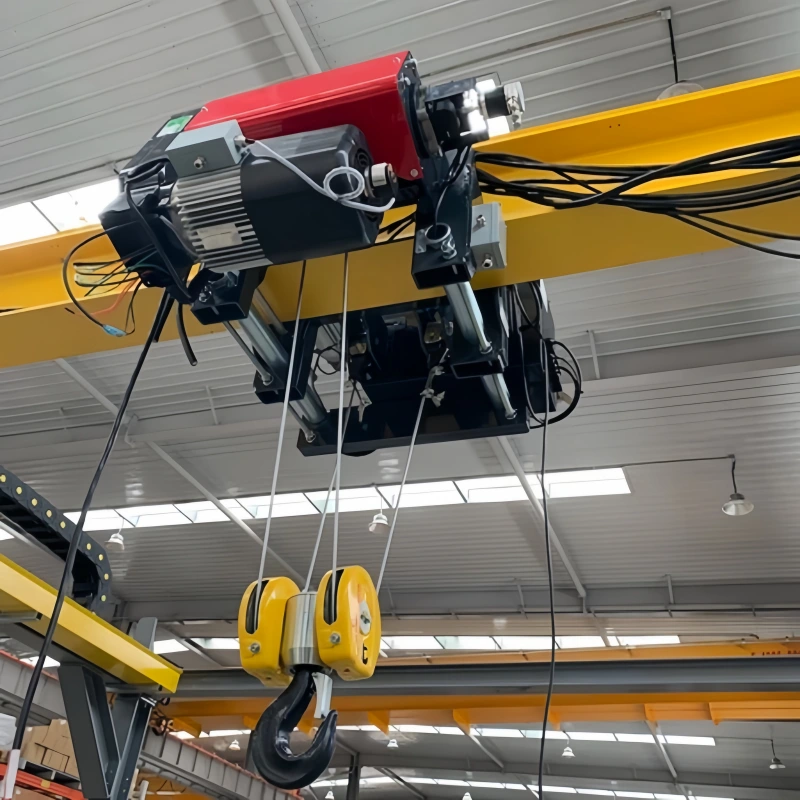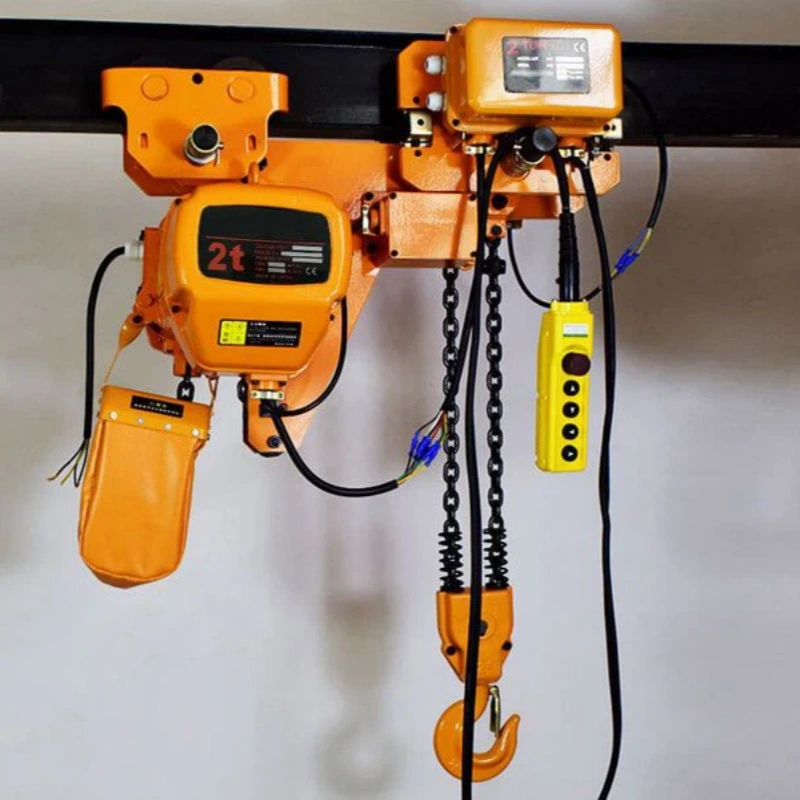When you work in rigging, the difference between grab hooks and slip hooks can determine both safety and efficiency in lifting operations. Grab hooks feature an open design that lets you control load lifting with precision, while slip hooks use a safety latch to prevent accidental release during overhead lifting.
The choice you make helps you pick the right hook for stable or dynamic environments. Powerful Machinery stands out as a trusted source for certified lifting hooks and lifting hook solutions that keep your overhead lifting secure.
Feature | Grab Hooks | Slip Hooks |
|---|---|---|
Design | Open for precise load control | Closed with a safety latch |
Safety | No safety latch | Safety latch prevents release |
Best Use | Stable lifting situations | Dynamic load lifting |
Efficiency | Quick attachment | Secure for frequent detachment |
Key Takeaways
Grab hooks provide precise load control for stable lifting situations, making them ideal for tasks like chain shortening and load binding.
Slip hooks feature a safety latch that prevents accidental release, making them the preferred choice for dynamic lifting and overhead operations.
Always inspect your rigging hooks before use to ensure safety features function properly and to prevent accidents during lifting.
Choose the right hook based on your specific application needs, considering factors like load type, environment, and required safety measures.
Powerful Machinery offers certified hooks that meet international safety standards, ensuring reliability and compliance for all your rigging needs.
Rigging Hooks Overview
What Are Rigging Hooks?
You rely on rigging hooks every day to move heavy loads safely and efficiently. Rigging hooks serve as essential connectors in lifting and rigging operations across construction, marine, and industrial settings.
These hooks provide a secure way to attach chains, slings, or ropes to loads, allowing you to lift, move, or position materials with confidence.
Rigging hooks give you a secure and efficient means of lifting and moving heavy loads.
They help maintain safety and boost productivity in material handling.
Specialized hooks, such as sorting hooks, ensure full engagement with the load for precise control.
Powerful Machinery stands out as a trusted provider of certified lifting hooks. The company’s products meet or exceed international safety standards, including OSHA, ASME, and ISO9001. You can count on regular inspections and ongoing compliance, which are critical for public safety and project reliability.
Note: Powerful Machinery offers training programs to help you and your team use rigging hooks safely and effectively.
Types of Lifting Hooks
You have access to a wide variety of rigging hooks, each designed for specific tasks and environments. Here are the most common types you will encounter in industrial rigging:
Eye Hooks – Permanent connections to slings, offering flexibility.
Clevis Hooks – U-shaped hooks for easy replacement and non-permanent use.
Swivel Hooks – Allow alignment or free rotation under load to prevent twisting.
Sorting Hooks – Used for sorting flat plates, requiring a specific angle for engagement.
Foundry Hooks – Designed for high-heat applications and specific load types.
J-Hooks – Slim profile for tight spaces, with lower load limits.
Grab Hooks – Narrow throat hooks for chain applications, ideal for types of grab hooks.
Drum / Barrel Hooks – Designed for lifting barrels in multi-leg sling assemblies.
Powerful Machinery’s certified product range includes Clevis Grab Hook, Hooks, Stainless Steel Hooks, and Clevis Slip Hooks. These lifting hooks are engineered for durability, corrosion resistance, and compliance with the latest safety standards.
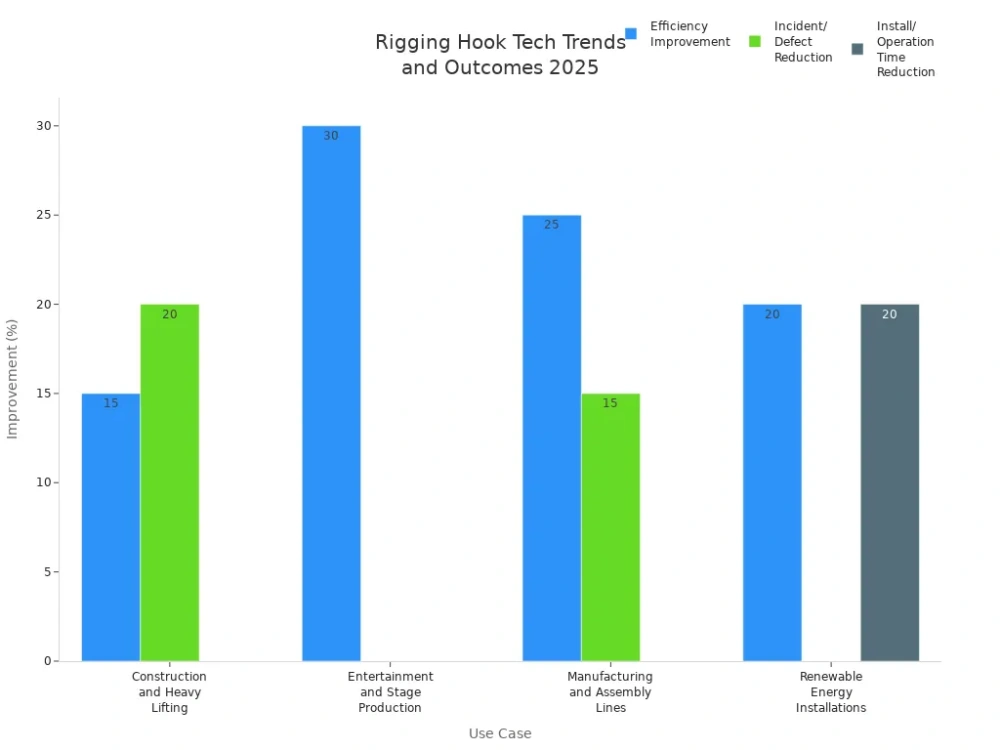
You benefit from innovations like corrosion-resistant materials and load-sensing technologies, which have reduced project timelines and improved safety across industries. When you choose Powerful Machinery, you gain access to advanced rigging hooks that support your operations now and in the future.
Grab Hooks in Rigging
Grab Hook Design
When you choose grab hooks for your rigging setup, you select a tool built for control and reliability. Grab hooks, sometimes called claw hooks, feature sharp, curved edges that resemble claws. This unique design lets you grab chain links or objects with irregular shapes and uneven surfaces.
You will find that the throat of the hook is narrow, which helps you grab a specific link in a chain and prevents the chain from slipping through. Powerful Machinery’s Clevis Grab Hook stands out with its forged, heat-treated steel body and a zinc finish that resists corrosion.
You can rely on this grab hook for heavy-duty use in harsh environments, knowing it will maintain its grip and strength over time.
Safety Features
You must always prioritize safety when working with grab hooks. These hooks are engineered to reduce the risk of load slippage and accidental release. Key safety features include:
The narrow throat design grabs the chain securely, preventing unintended movement.
Some grab hooks incorporate a safety latch to keep the hook from slipping out during use.
The bolt and cotter pin system on Powerful Machinery’s Clevis Grab Hook ensures a secure attachment to your chain, adding another layer of safety.
Each grab hook undergoes rigorous testing and inspection to meet international safety standards.
Tip: Always inspect your grab hooks before each use to ensure all safety features function properly.
Applications
You will find grab hooks in a wide range of industries due to their versatility and secure grabbing ability. Here is a quick overview of common applications:
Industry | Typical Applications |
|---|---|
Construction | Used on machinery like excavators and cranes for lifting heavy materials. |
Transportation | Secures cargo on trucks and trailers for safe transport over long distances. |
Agriculture | Attaches implements to farm equipment like tractors for various agricultural tasks. |
Manufacturing | Utilized on assembly lines and heavy machinery to move products and materials. |
You can use grab hooks for chain shortening, load binding, and precise load control. Their ability to grab and hold makes them essential for construction, marine, and mining operations. When you need a hook that grabs and holds under pressure, grab hooks deliver the performance and safety you require.
Slip Hooks and Their Role
Slip Hook Design
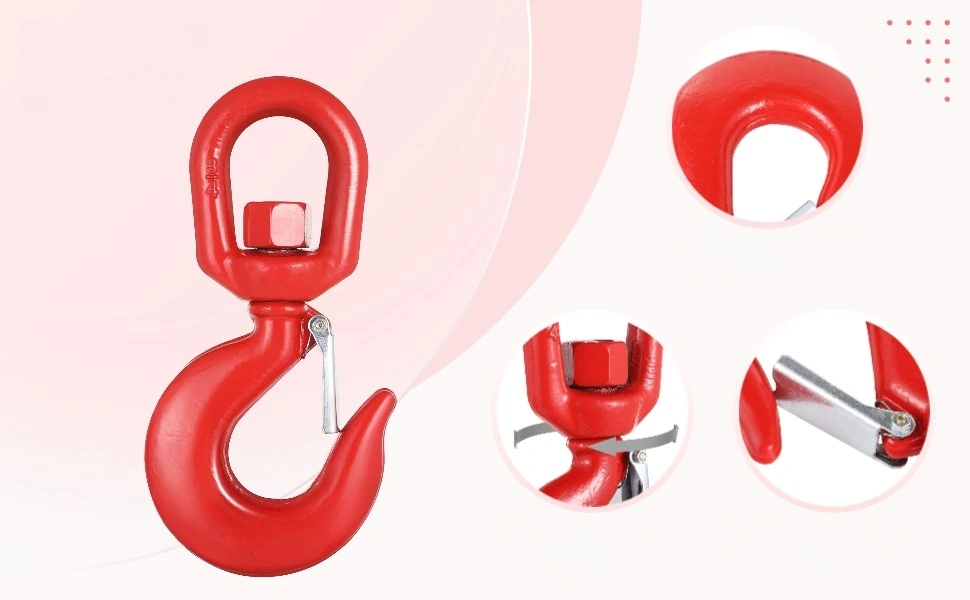
When you select slip hooks for your rigging setup, you gain a tool designed for secure and flexible load handling. Slip hooks feature an open design that allows you to attach and detach chains or slings quickly. The wide throat makes it easy to connect to various lifting applications.
You will notice that slip hooks use high-strength materials, which ensure durability in every heavy-duty application. The pivoting ability of these hooks lets you manipulate loads from different angles, giving you more control in dynamic environments.
Design Characteristic | Description |
|---|---|
Open Design | Facilitates easy attachment and detachment from loads. |
Safety Latch | Prevents accidental release of the load during lifting operations. |
High-Strength Materials | Ensures durability and reliability under heavy loads. |
Pivoting Ability | Allows for better load manipulation from different angles. |
Powerful Machinery’s Clevis Slip Hooks stand out in the market. You benefit from their robust construction, corrosion-resistant finish, and compatibility with multiple chain grades. These slip hooks perform reliably in construction, marine, and mining applications.
Safety Latch
The safety latch is a critical feature on slip hooks. You rely on this latch to keep your load secure during lifting applications. The latch prevents loads from slipping out of the hook, even when sudden movements occur. This feature is especially important in environments where dynamic forces can cause accidental release.
The safety latch keeps your rigging secure until you intentionally release the load.
You reduce the risk of accidents and improve overall safety on the job site.
Slip hooks with a safety latch provide peace of mind in every lifting operation.
Many professionals choose slip hooks with self-locking hooks for added security. These self-locking hooks automatically close and lock when under load, offering another layer of protection.
Common Uses
You will find slip hooks in a wide range of industries that demand secure and flexible rigging solutions. Their design makes them ideal for dynamic environments where loads may shift or move unexpectedly. Here are some of the most frequent applications for slip hooks:
Industry/Application | Example Projects/Companies |
|---|---|
Steel Mills | Steel bundle manufacturing in Canada |
Windpower | Envision in China, Siemens in Denmark, Vestas in the USA |
Nuclear | Dismantling of the Fukushima nuclear plant in Japan |
Mining | Mining sector projects |
Construction | LafargeHolcim collaborations |
Ports/Stevedore | Stevedoring operations |
Cement Production | LafargeHolcim cement production in the Philippines |
Aerospace | Boeing, SpaceX, Rolls-Royce |
Automotive | Michelin |
You can use slip hooks for overhead lifting, cargo handling, and other lifting applications that require quick attachment and secure load retention. Their versatility and safety latch make them a top choice for professionals who value both efficiency and safety.
Tip: Always inspect the safety latch before each use to ensure your slip hooks function properly and maintain the highest safety standards.
Difference Between Grab Hooks and Slip Hooks
Design and Security
You need to understand the key differences between grab hooks and slip hooks before selecting the right lifting hooks for your project. The design of each hook directly affects how you use it and how secure your load remains during rigging operations.
Feature | Grab Hooks | Slip Hooks |
|---|---|---|
Design | Open design without a safety latch | Closed design with a safety latch |
Safety | No safety latch | Includes a safety latch for security |
Functionality | Grabs objects directly | Requires an inward force to release |
Grab hooks have an open design. You can quickly attach them to a specific chain link, which gives you precise control over load positioning. However, this open design does not include a safety latch. You must stay alert, as the chain can slip out if the load shifts or if you do not maintain tension.
Slip hooks, on the other hand, feature a closed design with a built-in safety latch. This latch closes over the hook’s opening and keeps the chain or rope securely in place. You benefit from extra protection against accidental disengagement, especially when working in environments where loads may move or swing.
Note: The safety latch on slip hooks ensures that your load stays attached, even if you experience sudden movements or changes in tension.
When you compare the security features, you see clear distinctions:
Grab hooks have an open design without a safety latch, making them less secure against accidental release.
Slip hooks feature a safety latch that closes over the hook’s opening, providing a secure enclosure for the chain or rope.
The latch mechanism on slip hooks ensures that the load remains firmly attached even under strain, making them safer in dynamic environments.
These design and security differences play a major role in your choice of lifting hooks for each job.
When to Use Each?
You should always match the hook type to your specific rigging scenario. The difference between grab hooks and slip hooks becomes most important when you consider the nature of your load and the level of safety required.
Use grab hooks when you need to shorten a chain or bind a load with precision. These hooks work best for stable lifting situations where you control the load and do not expect sudden movement.
You often see grab hooks used for pulling or dragging materials, rather than for overhead lifting. Their open design allows for quick adjustments and easy chain engagement.
Slip hooks are ideal for situations that require extra security. The safety latch makes them the preferred choice for overhead lifting, cargo handling, and any application where the load may shift or move unexpectedly.
You gain peace of mind knowing the latch will keep the load attached, even if the chain slackens or the angle changes. Slip hooks excel in dynamic environments, such as construction sites, ports, and heavy equipment operations.
To summarize the key differences:
Grab hooks offer fast, precise control for stable loads but lack a safety latch.
Slip hooks provide a secure, enclosed connection with a safety latch, making them safer for dynamic or overhead lifting.
By understanding the difference between grab hooks and slip hooks, you make informed decisions that improve safety and efficiency in your rigging operations. Always assess your project’s needs and choose the hook that matches your application.
Rigging Hook Selection Guide
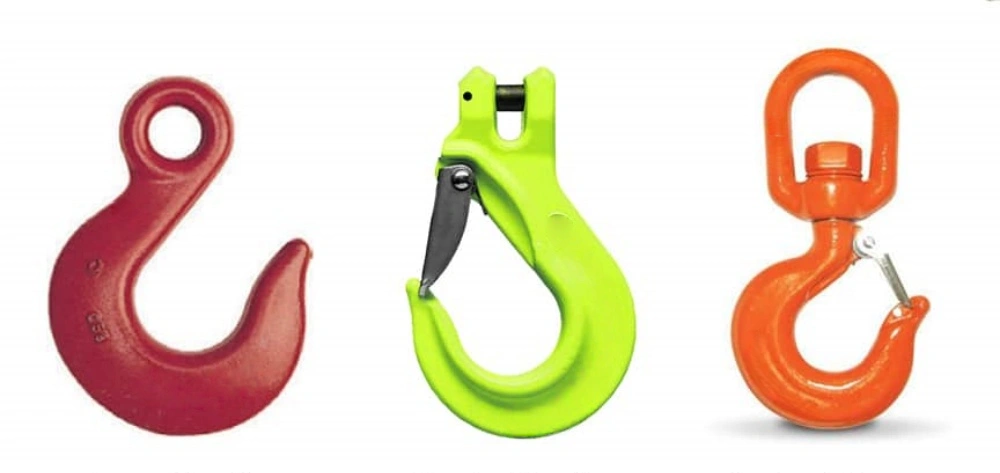
Grades and Materials
Understanding grades and materials is essential when you select rigging hooks. Grades refer to the strength and performance level of the steel used. Materials impact both durability and safety. Here is a quick reference table to help you compare common options:
Material/Grade | Performance Impact |
|---|---|
High Carbon Steel | Brittle, sensitive to stress and cracks. |
Low-Carbon Killed Steel | High mechanical strength and impact toughness. |
Low-Carbon Alloy Steel | Improved strength and performance over high-carbon steel. |
Die Forging Hook | Cost-effective, but total loss if broken. |
Laminated Hook | Multiple steel plates buffer pressure, retain overall integrity if damaged. |
You should always match the grade and material to your required strength and application. Powerful Machinery offers hooks made from high-quality Grade 100 alloy steel, ensuring maximum strength and reliability for demanding jobs.
Working Load Limit
The working load limit is the maximum load your rigging hook can safely handle. Manufacturers determine this value through rigorous testing. You must never exceed the working load limit, as doing so can lead to equipment failure.
The minimum breaking strength is always higher than the working load limit, providing a safety margin. Proof tests often apply loads twice the working load limit to verify strength and reliability. Always check the capacity and safety factor before every lift.
Tip: The safety factor is the ratio between the minimum breaking strength and the working load limit. A higher safety factor means greater protection against unexpected overloads.
Application Matching
Selecting the right hook for your application ensures both safety and compliance. Use this table to guide your choices:
Hook Type | Description | When to Use | Key Considerations |
|---|---|---|---|
Eye Hooks | Permanent, welded, or forged eyes | Overhead lifts with slings or chains | Always use a safety latch for overhead lifting |
Attach via pin, used with a chain | When load control is crucial | Never exceed the working load limit | |
Latch Hooks | Include a safety latch | Loads that rotate or align mid-lift | Choose the correct grade for your application |
Swivel Hooks | Allow load rotation to prevent twisting | When the load needs to rotate | Ensure compatibility with rigging and load |
Powerful Machinery provides certified hooks with secure latching mechanisms and customization options, such as patented Twist Lock Cradle Grab Hooks.
You can select hooks for chain-to-chain connections, equipment safety chains, or vehicle stabilization. Always consider the safety factor, capacity, and minimum breaking strength for every job.
Note: Most rigging hook failures result from unknown load weight, lack of inspection, or using the wrong hook for the application. Regularly inspect your gear and consult rigging charts to maintain safety.
Powerful Machinery Product Highlights
Clevis Grab Hook Features
You can rely on Powerful Machinery’s clevis grab hooks for secure and precise load control. These hooks feature a forged, heat-treated steel body that delivers exceptional strength and durability. The zinc finish protects against corrosion, making them suitable for outdoor and industrial environments.
The narrow throat design allows you to grab a specific chain link, which helps you shorten chains or bind loads with confidence. You benefit from a bolt and cotter pin system that ensures a secure connection to your chain.
These grab hooks meet strict international safety standards, so you can trust them for demanding lifting tasks in construction, transportation, and mining.
Clevis Slip Hook Features
Powerful Machinery’s clevis slip hooks offer a combination of safety, versatility, and ease of use. You get a high-strength alloy steel construction that stands up to heavy loads. The safety latch prevents accidental disengagement, keeping your load secure even during dynamic lifting.
The corrosion-resistant coating ensures long service life, even in harsh conditions. You can use these slip hooks in a wide range of applications, from construction to rescue operations. The user-friendly design allows for quick attachment and detachment, which boosts your productivity.
Feature | Description |
|---|---|
Durable Construction | High-strength alloy steel resists bending and wear. |
Safety Latch | Prevents accidental slips and keeps loads secure. |
Versatility | Suitable for construction, rescue, and industrial use. |
Corrosion Resistance | Protective coating ideal for tough environments. |
Tip: Choose clevis slip hooks when you need both safety and adaptability for your rigging operations.
Stainless Steel Hooks for Marine Use
If you work in marine or corrosive environments, Powerful Machinery’s stainless steel hooks provide unmatched performance. These hooks use 316 stainless steel, which resists corrosion, pitting, and crevice corrosion—even in saltwater.
The polished finish adds both durability and a professional look. You can use these hooks in construction, marine, and kitchen settings where strength and corrosion resistance matter most.
316 stainless steel ensures long-lasting durability in wet and salty conditions.
The hooks maintain their load ratings, so you can safely handle heavy weights.
Always check the manufacturer’s specifications to match the right hook to your application.
Note: Stainless steel hooks from Powerful Machinery are ideal for marine professionals who demand reliability and safety.
Conclusion
You see clear differences between grab hooks and slip hooks in rigging. Grab hooks offer precise control for stable loads, while slip hooks provide extra security with a safety latch for dynamic lifting. Choosing the correct lifting hooks improves workplace safety and efficiency.
Eye hooks with safety latches work best for fixed loads.
Swivel hooks help prevent twisting during load positioning.
Shur-Lock hooks add protection for critical lifts.
Consulting with rigging experts ensures you select the right hook and comply with safety standards. Powerful Machinery supports your needs with certified products and expert guidance.
FAQ
What is the main difference between a grab hook and a slip hook?
You use a grab hook to hold a specific chain link for precise load control. A slip hook includes a safety latch that keeps the chain or sling from slipping out during lifting.
How do I choose the right hook for my application?
You should consider the load type, working environment, and safety requirements. Always check the working load limit and select a hook grade that matches your chain or sling.
Are the Powerful Machinery hooks certified for international standards?
Yes. Powerful Machinery hooks meet or exceed major international certifications, including ISO9001, TUV Rheinland, and OSHA. You can trust their products for global compliance and safety.
How often should I inspect my rigging hooks?
You should inspect your hooks before each use. Look for signs of wear, deformation, or corrosion. Replace any hook that shows damage or fails to meet safety standards.

